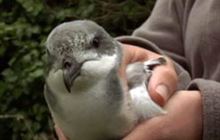Chatham petrel/ranguru
Introduction
Once widespread on the Chatham Islands, the Chatham petrel was until recently restricted to Rangatira Island but active management has allowed the population to grow on other islands.National status: Endemic
Conservation status: Threatened–Nationally Vulnerable
Found in: Chatham Islands
Threats: Predation, competition
Species information: Chatham petrel on NZ Birds Online
Image gallery
-
Chatham petrel in artificial nest cavity Image: Don Merton | DOC
![Petrel in artifical nest cavity. Petrel in artifical nest cavity.]()
-
Chatham petrel burrows, the top right one has a green neoprene flap Image: Helen Gummer | DOC
![Burrows - one with a flap. Burrows - one with a flap.]()
-
Petrel and prion burrows Image: Leon Berard | Creative Commons
![Burrows on forest floor. Burrows on forest floor.]()
Did you know?
Chatham petrel can forage up to 3,000 km from the colony.
Chatham petrel conservation
There is evidence that Chatham petrels were once widespread on the Chatham Islands and one of the more abundant burrowing seabirds.
But with the loss of forest habitat on Chatham and Pitt islands, and the introduction of mammalian predators such as cats, rats and pigs, Chatham petrels became confined to predator-free Rangatira Island by around 1900. Until recently this remained the sole breeding site.
Even after farming on Rangatira stopped in the early 1950s and a considerable area of forest was recovered, Chatham petrel numbers were declining. There were only 30 breeding pairs known in the 1980s.
There are now an estimated 2000 individuals with close to 130 chicks fledging each year, across three sites. The population has been managed since 1992 in the effort to increase productivity.
Predator control
A key part of DOC's work on Rangatira island is to ensure that no unwanted pests, like rats or mice, arrive on the island where they might have a serious impact on Chatham petrel and other vulnerable birds.
Burrow management
DOC staff make several trips to Rangatira Island every year to manage Chatham petrel burrows to maximise chick productivity.
Artificial burrows are installed for known breeding pairs. These burrows are blocked off over winter when the petrels are away to ensure that broad-billed prions do not take over in their absence.
Neoprene flaps, designed by Lincoln University, are fitted over the burrow entrances. The flaps allow the petrels through but deter most prions from entering. Staff also make regular inspections of the nests during periods of peak prion activity.
Translocations
Chicks, collected late in the breeding season, have been translocated to predator-fenced sites on Pitt and Chatham Islands where they have been fed until their departure to sea. This, along with a sound system playing petrel calls has been successful in establishing small breeding colonies on Pitt and Chatham Islands.
You can help
Emergency hotline
Call 0800 DOC HOT (0800 362 468) immediately if you see anyone catching, harming or killing native wildlife.
If you are travelling to the Chatham Islands, or transporting goods or livestock there, be careful that you don't introduce pest animals or plants or diseases. They could threaten Chatham petrel or other rare and endangered flora and fauna in this unique environment.
Your sponsorship can help DOC with the conservation management techniques used to protect Chatham petrel, including:
- Radio telemetry, used to catch and track adult birds and follow them to their burrows. This helps to increase the number of burrows under management.
- Predator fencing to create new sites for Chatham petrel colonies.
- Translocation and feeding of chicks at new sites.
Listen to the Radio NZ Our Changing World programme featuring Chatham petrel




